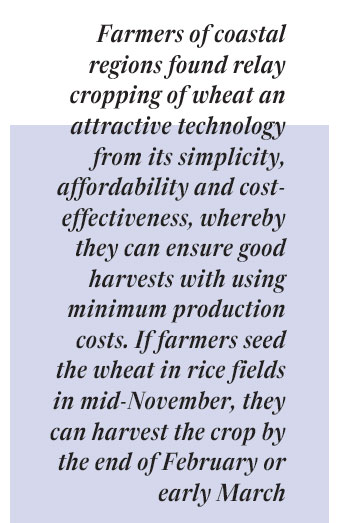
DR M G NEOGI
The country has a total area of 147,570 square kilometres. The coastal region of Bangladesh spans approximately 47,201 square kilometres, accounting for one-third of the country’s total land area. The coastal zone of Bangladesh covers 20% of the land area and is inhabited by approximately 42 million people. About 64.7% of these coastal inhabitants depend on agriculture, and about 30% of them live below the poverty line.
The adverse impacts of climate change have had particularly severe consequences for coastal farming communities. Looking at the main cyclones/tornadoes that were created in the Bay of Bengal in the last 53 years (from 1970 to 2023), it is clear that their frequency has increased two to three times in a year since 2021. It may be noted that most of these cyclones hit in May (10 times), the hottest month in Bangladesh, whereas five cyclones lashed in November, the country’s main crop, Aman paddy’s ripening time. Climate risks to agricultural production are expected to increase in coming decades, particularly in low-income countries where adaptive capacity is weak.
In Bangladesh, agricultural cultivation of the entire coastal region is being threatened by climate change. Rising sea levels and reduced freshwater flow from upstream rivers have caused saline water to seep into agricultural lands. Soil salinisation impairs crop growth and yields and thus limits the types of crops that can be cultivated. All these environmental issues severely affect crop and cropping patterns, leading to decreased agricultural productivity and food insecurity in the area.
Despite advancements in modern science, almost 439,000 hectares of land remain fallow during the dry season. Earlier farmers of this region used to cultivate dry season rice (Boro) and other winter crops in the dry season and received a very good yield and income. But nowadays, failing to gain optimum yield again and again due to increased salinity and severe scarcity of salt-free irrigation water as well as lack of drainage facilities, farmers abandoned Boro rice and winter crop cultivation. As a result, most of the land remains fallow in the dry season (from January to June/July). Hence, most of the farm households in the coastal region cultivate only one crop in a year, i.e., long-duration local Aman rice in monsoon (July to December).
Experts have also observed an increase in annual rainfall due to the changed climate. The total annual rainfall has increased at a rate of +5.53 mm yr-¹ from 1958 to 2007. A significant increase in pre-monsoon rainfall at the rate of 2.47 mm yr-¹ is also observed over Bangladesh. The rate of increase was approximately 5.5% per decade between 1958 and 2007. Rainfall in pre-monsoon during May, June and July is more than 1000 mm yr⁻¹, which has been wasted due to the dearth of scope to utilise this excessive rainwater.
On the other hand, Bangladesh has the highest population density in the world, with more than 1000 people living per square kilometre. The Agriculture Census-2019 reported that Bangladesh’s farmland has been decreasing at the rate of 0.19% every year. They confirmed that the country’s net arable land has declined to 18.68 million acres (7.562 hectares) in 2019 from 19.09 million acres in 2008. Between 1976 and 2000, 23,850 hectares (ha) of land went to rural settlements annually, while the amount was 30,809 ha between 2000 and 2010. The cultivable land is decreasing to give space for development and housing for the increased population.

In order to meet the escalating food demand resulting from the continuous population growth, it is imperative to bring the substantial area of fallow land under cultivation during the dry season. Given the availability of arable land and the absence of viable alternatives, maximising the use of this land is essential to enhance agricultural productivity and ensure our national food security. Major research is necessary to develop and accommodate climate-smart agricultural technologies for the farm households of this region in order to green the fallow saline coastal land during the dry season in a profitable way.
To address this issue, as well as to develop affordable and the most viable technology to cultivate crops on barren saline land during the dry season, the Australian Centre for International Agricultural Research (ACIAR) is coming up and conducting extensive research in barren lands of coastal regions of Bangladesh in the dry season under Australia-Bangladesh joint collaborations. The University of Western Australia (as lead agency), along with the Poverty Eradication Programme, has been implementing field research on relay wheat cropping technology in farmers’ saline land of coastal regions during the dry season since 2021. The local government office of the Department of Agricultural Extension (DAE), the Bangladesh Wheat and Maize Research Institute (BWMRI) and the local office of the Bangladesh Institute of Nuclear Agriculture (BINA) also provided necessary cooperation in this prolific research under ACIAR support.
There are five major reasons to introduce wheat cultivation research into fallow saline land of coastal regions:
Salinity tolerance capacity: Wheat naturally can tolerate some level of salinity and requires minimal water for irrigation. Thus, wheat is a good option to introduce in such a medium saline soil.
Minimum irrigation requirements: In the coastal region, water of a suitable quality for irrigation is scarce, and wheat cultivation has a low irrigation requirement of only 3-5 light irrigations to complete its life cycle. Thus, wheat would be a good choice to cultivate in coastal saline fallow land during the dry season.
Changing of food habits: Rice alone cannot meet the food requirements of the country. There is rapidly increasing demand for wheat among Bangladeshi people due to their changes in food habits, with wheat becoming a highly desirable food supplement to rice.
Highly dependent on wheat importation: Bangladesh is becoming highly dependent on wheat importation as dietary preferences are changing. Currently, Bangladesh requires 7.5 million tonnes of wheat annually but produces only 1.1 million tonnes annually, meaning the rest is imported.
Scarcity of available land: Scarcity of available land for wheat cultivation makes it difficult to meet the needs. The scope to expand wheat cultivation is almost zero due to other competing crops, such as potatoes, maize, etc. The most vital reason for cultivating wheat in coastal regions is the availability of uncultivated land during the dry season, which may be possible to bring under wheat cultivation to meet the nation’s demand.
Now a question may arise – why relay cropping technology is necessary for wheat cultivation in coastal regions! There are the following three important factors to ensure one additional harvest after Aman rice.
Timely planting: In coastal regions, Aman rice is mostly harvested in December. Wheat likes cooler weather, growing best at temperatures below 150 degrees Celsius, particularly in its vegetative growth and head formation stage. Based on my five years of research in coastal saline fallow land, it is understood that the optimum planting time of wheat in the coastal region of Bangladesh is in mid-November, when the rice crop is still standing in the field in its semi-maturing stage. So, it is hard to sow wheat seeds on time, i.e., in mid-November.
Thus, to overcome this timing issue, the relay wheat cropping technology proves an excellent alternate. The relay wheat cropping is a technology to broadcast wheat seeds directly into the standing Aman rice fields in mid-November, when the Aman rice crop is still in the maturing stage, prior to harvest.
Relay wheat cropping enabled wheat cultivation at the right time without disturbing the standing rice crop, which proved to be the most suited technology for the coastal farm families for their fallow saline belt in the dry season. Thus, the relay cropping technology opens a window to cultivate a second crop in the same land without disturbing the first crop.
Minimum or no salinity level: In most of the coastal regions, soil salinity levels are normally lower in mid-November while gradually increasing in the following months.
Availability of soil moisture: Most fields in coastal regions retain sufficient moisture in mid-November. Thus, planting of wheat this time enables crops to fully utilise the residual soil moisture when soil salinity levels are still tolerable.
So, without any further land preparation, farmers are getting good yields from wheat cultivation in favourable soil conditions and environments where production costs are less compared to conventional wheat cultivation. As such, the above three factors collectively contributed to the remarkable success of relay wheat cultivation in saline fallow lands of coastal regions.
Farmers of coastal regions found relay cropping of wheat an attractive technology from its simplicity, affordability and cost-effectiveness, whereby they can ensure good harvests with using minimum production costs. If farmers seed the wheat in rice fields in mid-November, they can harvest the crop by the end of February or early March.
The land, while previously fallow in the dry season, now becomes productive. The relay wheat farmer of Daulatpur village, Md. Sarwar Hossain, informed us that last year, he cultivated wheat under the conventional system, received a yield of seven mounds (280 kg) from one bigha (33 decimal) of land, and sold those at Tk 14,000, where the total cost was more than Tk 6,000. This year, by relay wheat cropping, he harvested 10 maunds (400 kg) from one bigha. He also informed us that the villagers now have enough confidence to grow relay wheat and requested the government to provide them with seeds and irrigation facilities.
We hope that the government will critically analyse the relay wheat cropping in saline fallow land in favour of coastal farm families while requesting to ensure irrigation facilities and availability of wheat seeds, which could be a revolution to greening the coastal fallow saline land.
_____________________________________________
The writer is working in the coastal regions of Bangladesh under Griffith University of Australia, where ACIAR is supporting the programme. He may be reached at [email protected]

